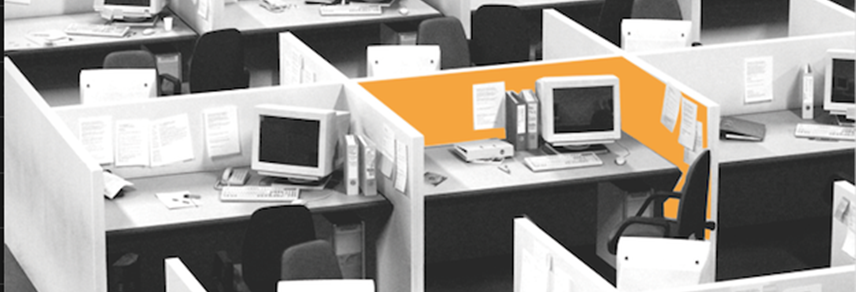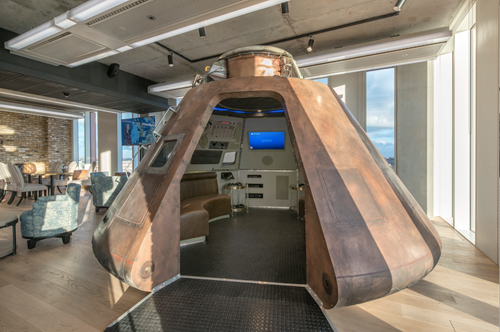
FORM FOLLOWS FUNCTION
Employee engagement and happiness are contingent on the working environment. Companies are moving away from siloed, compartmentalised offices to embrace new forms of working. Can workplace architecture help or hinder employee morale? Amy Sandys reports
Walking into the King’s Cross office of electronic market-maker company XTX Markets is simultaneously stepping back, and forward, in time. Even the term ‘office’ is too nondescript, in fact, for the quantitative-led, Steampunk-inspired, sci-fi-oriented workspace in which XTX Market’s approximately 100 employees work, and socialise, and sleep. To reflect the firm’s tech-led ethos, employees are greeted by an algorithmic pentagonal tiling pattern with an infinite number of sequences. There’s also a clock so abstract most visitors can’t specify its function. And that’s just the entrance. “For the employees, we needed an intimate meeting space that could double up as a social activity space, so we created an Apollo 11 replica,” says Steve Taylor, project director at workplace interiors specialist Peldon Rose. “We also [believe] the less corridors you have the better, but of course people have to move between areas. So, we created an airlock chamber.”
Airlock chamber or otherwise, when designing workplace environments, companies must be mindful of how function and form interrelate to produce optimum results. In a corporate climate increasingly characterised by reputation and trust, workplace environment is often the first touchpoint for employees, employers and clients. From an employer brand perspective, it is arguably the most important. The physical workplace offers the first impression for new recruits; how an organisation functions within a physical structure and its material benefits can influence retention rates.
Take UK discount sports retailer Sports Direct. Its warehouses became a key battleground in wider discussions around its employee practices, the physical working environment symptomatic with wider issues around employee mistreatment, harassment and underpay. For both potential employees and customers, the brand portrayed in the media became synonymous with the lack of care in its workplace practice.
“Extensive research, along with anecdotal evidence, suggests that there is a strong correlation between office design and productivity,” says Dawn Bingham, talent consultant at architectural firm Benoy. “Employee surveys show a connection between workplace satisfaction and high employee engagement. Surveys also show highly engaged employees are less likely to leave their employment, take less days off sick and are more productive.” With the workplace environment no longer the preserve of Microsoft computers and a stationary cupboard, putting employees at the front and centre of any workplace interior project is key to success for the project, and the company aims. For Taylor, the workplace environment is core to the function-first argument which defines much architectural practice. “I’m a great believer in function first and the form comes second,” says Taylor. “All manner of activities happen in an office, and it’s ignorant to think that people only go to an office to sit at a desk and work. People go to an office to collaborate, to talk, to socialise, to eat, to work, to play – and then to do their daily function.”
This theory informs Peldon Rose’s broad architectural approach and manifest especially through XTX Markets’ move from Mayfair to King’s Cross. Tied into an affirmation of the brand’s new identity as one of the fastest-growing electronic market providers in the UK, XTX Markets required a workplace environment befitting the principles on which the company operates. Apart from XTX Markets’ signature Pantone blue, says Taylor, it wasn’t particularly important for Peldon Rose to include any previous brand or workplace aspect in the design process. In fact, as a technology firm, continual development and brand innovation is part of XTX Market’s remit.
“In terms of the identity, Peldon Rose was trying to create the outward impression of a forward-thinking, pioneering tech business,” says Taylor. “The essential characteristics come from a high-tech, coding, algorithmic pattern and a demonstration of what XTX Markets is all about.” By integrating core aspects of XTX Markets’ ethos into its workplace environment, a sense of belonging surrounds the employees, enhanced by quirks of the building derived from the CEO’s own interests in sci-fi, mathematics and the Victorian industrial era-inspired subgenre, Steampunk. Incorporating such unique themes meant going beyond architecture, says Taylor, and facilitating effective internal communication in a workplace characterised by informality and trust. “The most important thing is autonomy and freedom – if you have the skills to offer the business, a great employer will recognise that. They’ll expect you to tell them your ideas, and that’s why we invested a lot of thought into all the other areas such as social.”
Social wellbeing in the workplace is not confined to the private sector, however. Committed to enhancing transparency and democracy in its institution is the London-based Metropolitan Police Service. As an organisation based on the Hegelian principles of fostering a state-serving public body and the saying, ‘The police are the public and the public are the police,’ the Met needed to communicate its external commitment to democracy and transparency while maintaining an internal structure based on rank and order.
However, the Met had also to avoid what Bingham describes as, “The old corporate environment of individual offices, closed doors and separate floors for different levels of seniority, stifled new ideas and collaborative working and had the effect of segregating employees.” At New Scotland Yard, this claustrophobia is avoided through the architecture itself, says Yvonne O’Hara, head of internal communications at the Metropolitan Police Service. “The building itself is incredibly light build, there’s a huge amount of glass and that definitely creates a feeling of openness to the general public.” New Scotland Yard benefits from its open plan space and ‘open door’ policy, she says, which allows staff across all ranks to generate ideas and insight – and has proved useful for the communications department. “In comms in particular – press, social media, marketing and internal comms – since we’ve moved here we work in a more integrated way.” The new office space, says O’Hara, means that face-to-face contact has increased. Now, rather than sending a faceless email across different departments, human interaction has made for a more effective internal structure. “The old New Scotland Yard was still a working environment where you had your own office, a certain group of people worked in one place,” says Steph Day, head of marketing at the Metropolitan Police. “Just going open plan has improved connections, improved relationships, there’s no physical barriers to going and talking to somebody – it’s really changed the core of the organisation.”

In many organisations, the removal of physical workplace barriers and siloes means taking practical steps to wayfinding. At international architectural firm Benoy, for workplaces to facilitate an effective working environment, employees must easily navigate their workspace and feel included in any change. “Thought needs to be given to wayfinding around the workplace making it easy to find teams and individuals to ensure efficient working,” says Bingham. “Different colours schemes used to identify different team spaces can help as well as providing a variety of aesthetically pleasing backdrops to add to the happiness of employees. Wellbeing can be enhanced by the addition of natural planting or creating outside spaces.”
In other instances, using what Peldon Rose describes as ‘landmarks’ means interior architecture relates to its external built environment. This is particularly effective for XTX Markets, where the newly-developed technology hub of King’s Cross serves as the ideal environment from which the company can continue to make headway in the electronic markets space. “Our influence came from that raw industrial nature of King’s Cross, the integrity that London builders have – think London brick, stripped floors, exposed duct work and getting that industrial loft space,” says Taylor. “It was a beautiful way of addressing the space, to give it some authenticity and make it seem like a cool London hangout. The actual environment is going to be futureproofed for the next 20 years because we’re using materials, products that we’ve seen around us for 150 years, but we’ve applied them in a beautiful way.” Externally and internally, the architecture of XTX Markets works harmoniously to communicate the atmosphere the relocation to King’s Cross create.
Neighbouring the likes of Google and Central Saint Martin’s also meant, for XTX Markets, that creating a desirable workplace environment was necessary to promote the workplace array of competing institutions. “If you’re going to King’s Cross as part of this new technology drive, you’re going there because you’re trying to attract talent,” says Taylor. “If you’re going to walk through the front doors, you’ve got to show everything in the office rivals the very best leaders in technology.” Balancing external brand development with internal communications strategy is challenging. But forward-thinking organisations such as XTX Markets show how applying the same brand ethos within and without generates the same sense of belonging for employees as it does customers.
At architectural firm Benoy, this is reflected in the personality of the consumer-facing brand shines through across its corporate and employee space; creative use of space underpins the brand all over. “Consumer environments are orientated around experiences which are immersive, memorable and build brand affinity,” says Andy Piepenstock, design director at Benoy. “The modern corporate environment encourages creativity and collaboration in generous environments that nurture employees.” Encouraging this collaboration throughout the entire workplace enables the values on which Benoy’s brand promise is driven to thread throughout all aspects of the organisation. This is particularly vital in its employer brand promise, which for Benoy hinges on its ability to recreate the same sense of adventure its clients come to expect. “If designed with flexibility in mind, [corporate space] becomes well-utilised creative spaces, an important ingredient in our Benoy studios. Both share a requirement to create a unique personality and proposition,” he says.
At New Scotland Yard, the theme of heritage runs throughout the organisation’s interior environment and employer brand ethos. It also shows how the organisation relates its work to the wider public. From opening the building for London’s annual Open House exercise, to screens carrying campaign messages targeted towards employees traversing its main antechamber, functionally the Met is piqued for scrutiny. And for visitors, media and employees, interest is piqued by the classic New Scotland Yard sign that revolves in the building’s foreground.
“With the old building, from a certain place you could see the sign from inside, but in New Scotland Yard it’s very visible,” says Day. “People feel really inspired by the sign, it’s a key part of the organisation and it feels more accessible because of social media now – the public really felt a connection with us, and its symbolic way of that connection coming to life.” Though external, the connection between New Scotland Yard’s branding and its values of transparency help cement an internal culture that stands up to scrutiny. For the Met Police, it’s a step towards fully integration in an organisation historically compromised by its hierarchical structure. Quirks, such as each bathrooms displaying different decades of police car livery, is proof that, even in the most serious organisation, creative approaches enhance engagement.
The adage of form following function may have developed during the industrial era, a time of imagined prosperity and a mechanical future. Yet the sentiment remains. Insomuch as function follows form, Piepenstock says getting to know the end user first through research and insights is behind a successful architecture development process. Key in recruiting new employees, retaining existing workers and contributing to overall wellbeing and contentment, optimising workplace environments to ensure contented workforces remains vital. “Be clear on your purpose and objectives then build the experience around this,” Piepenstock explains. “Futureproof with an understanding of the trends and factors that influence your sector and then innovate using this insight.”
Almost universally across sectors, it’s no longer adequate to offer 25 days annual leave and a gym membership. Intangible benefits are core to many employer brand offerings and scrutiny of the physical environment is high from employees and potential recruits. If the office ceases to function, so too will
the workforce.



